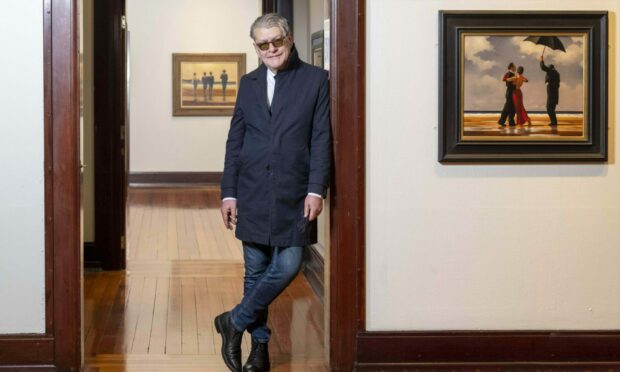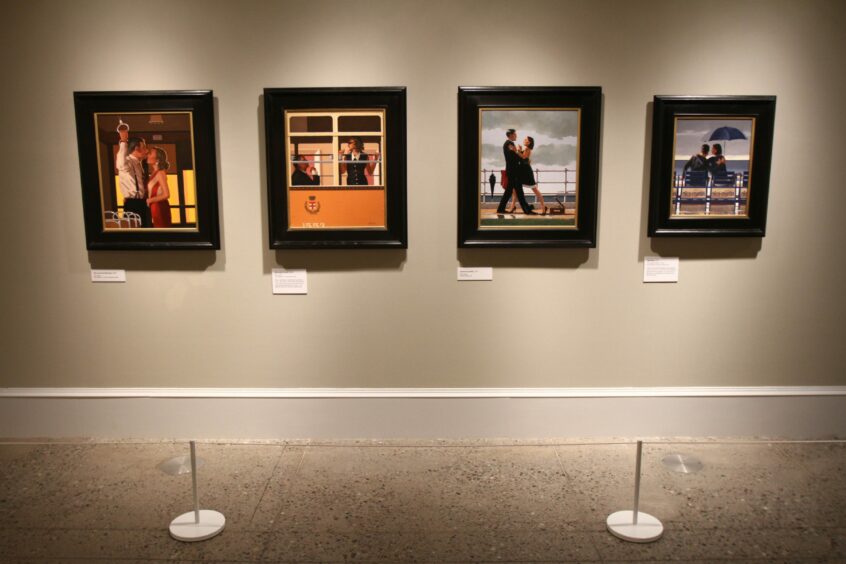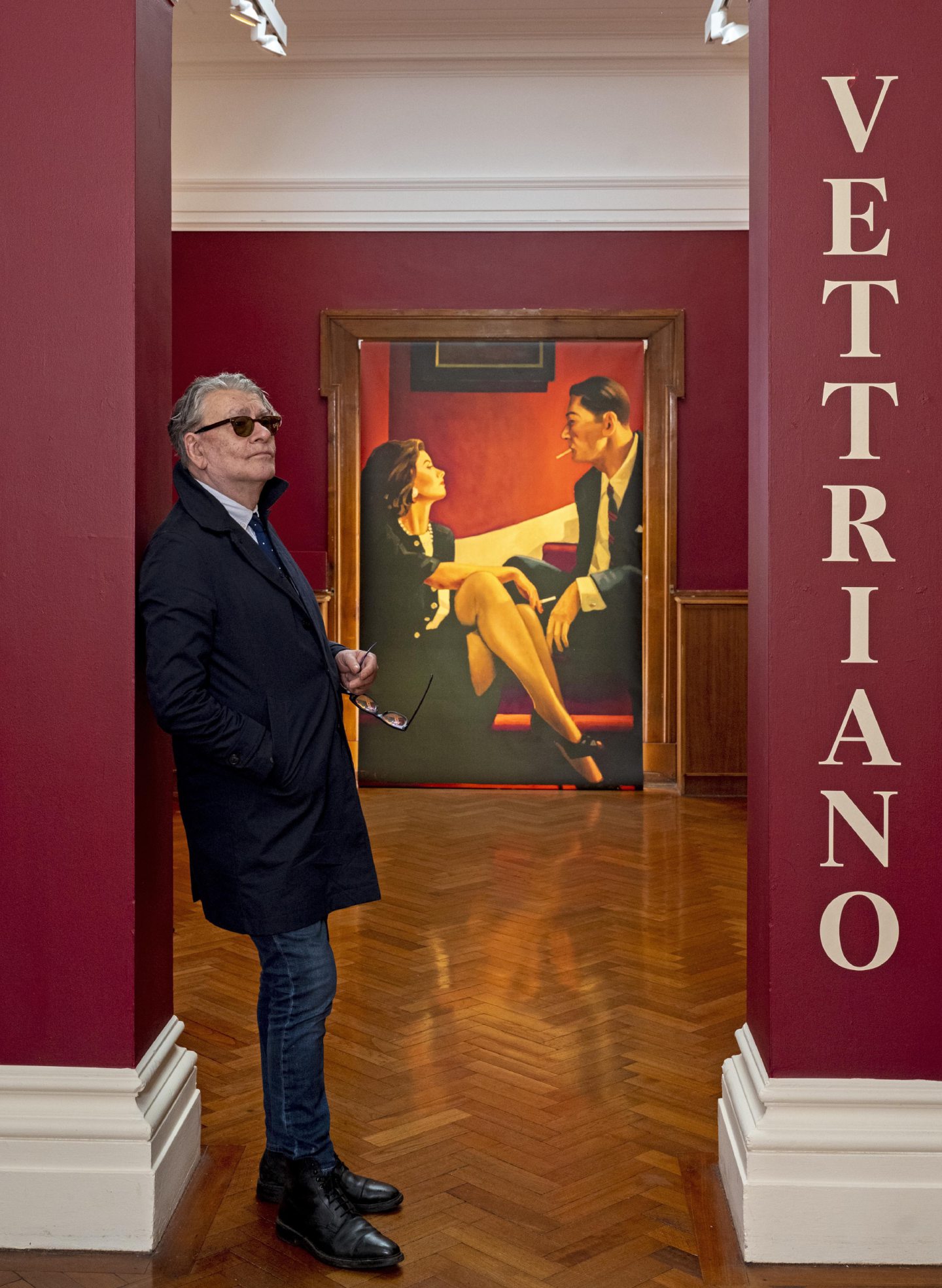Three decades have passed since Fife artist Jack Vettriano finished working on the painting that would change his life.
The dark grey skies and the harsh coastal winds captured in 1992’s The Singing Butler, which went under the hammer for close to £750,000 12 years later, are a familiar sight to those who grew up on the east coast.
Vettriano’s depiction of a couple dancing on the beach – joined on the sands by their staff, who diligently attempt to shield them from the elements with two, large black umbrellas – has since become one of the most popular artworks in Scotland.
Speaking to Vanity Fair in 2012, the 71-year-old described it as “an uplifting fantasy” that “makes people feel good”.
Now Fife Council is attempting to raise funds for a statue tribute to The Singing Butler on Leven Beach.
But the story behind the painting, like the life and times of its Methil-born creator, is complex.
Plagiarism scandal
After its release, the work was loathed by critics, with some calling it “unimaginative” and others describing Vettriano himself as someone who “wasn’t a painter… he just colours in”.
But the plagiarism scandal of October 2005 added more than just a splash of controversy.
That’s when Edinburgh designer Sandy Robb accused Vettriano – born Jack Hoggan in 1951 – of copying some of his drawings from the Illustrator’s Figure Reference Manual.
The manual, published in 1987, acts as a DIY-guide for artists to learn to draw different aspects of the human form.
In the book’s waltz section, a dancing couple resembled Vettriano’s Dance Me to the End of Love, while Elegy for the Dead Admiral appears to bring together figures from different sections of the manual.
The characters of The Singing Butler were also among those he was accused of copying.
🎨Jack Vettriano The Singing Butler pic.twitter.com/9qUdYD7yGJ
— 🌿🏝️Devi Pic's&Paintings🎨 (@Make_u2_happy) January 5, 2022
Sandy encountered the similarities after being asked by his friend George Clark, from Fife, to design invitations for his wedding.
He told The Daily Record: “I thought one of the images looked familiar but couldn’t think why – until I realised it was from Vettriano.”
Sandy’s intervention made headlines across the UK.
Vettriano’s agent, Tom Hewlett, said: “It is widely known that Jack is a self-taught artist.
“It seems unsurprising that as in his early painting years he had neither time nor money at his disposal to work with real-life models, and that he should use a teaching manual such as this.
“Vettriano’s skill lies in his ability to create narrative paintings with which the viewer becomes involved.
“In this way, he transforms mundane characters into extraordinary ones, and everyday scenes into special occasions.”
Vettriano – whose works have been bought by showbiz A-listers including Jack Nicholson and Madonna – came out fighting later that month.
He said: “So I used that manual for precisely what it is there for: to help people who don’t have access to models to construct something.”
The Fifer, who took up painting in 1972 and says his first models were prostitutes, insisted the book was a part of the artistic process “no more than a tool, just like brushes or canvas”.
He added: “I just wish people would look at the figures in that book, compare them with that painting and then tell me honestly that the guy who painted it isn’t creative, that he doesn’t have something going for him.”
A year later, he told BBC Scotland: “Yes, I did copy those figures from a manual.
“But no, I didn’t lift the whole painting. I had to actually construct the paintings.
“Besides, in a sense I was using a book that was intended for that purpose.
“I think the implication behind it all was that I was stealing somebody else’s idea and that just wasn’t the case.”
There was to be one, final twist in the saga of The Singing Butler.
In 2008, the painting’s ‘lady in red’ was revealed to be Irish actress Orla Brady, who starred as Cathy in the TV adaptation of Wuthering Heights and has also appeared in Absolutely Fabulous, The Vicar of Dibley, Wallander, Mistresses and Death in Paradise.
She modelled for the Illustrator’s Figure Reference manual in her 20s and says she was paid £50 and “thought no more of it”.
Orla later told Mail Online: “I didn’t know about the picture’s existence until someone asked me about it a few years ago.
“As soon as I saw it, it was obvious it was me.
“I didn’t find it weird. The book was designed for artists who couldn’t afford life models – and he’d used it as it was intended.”
The work of Vettriano, no stranger to headlines about his colourful love life, has since gone global but it all started in Fife.
And The Singing Butler statue proposed for Leven Beach – as part of a multi-million pound overhaul of the town’s waterfront – would celebrate his local roots.
Designers say the Vettriano tribute could become “an iconic landmark”.
The self-taught artist lived in a small miner’s cottage growing up in Methil with his parents and his three siblings.
He followed his dad, Bill, down the pits and also worked as a bingo caller in Leven.
But his life changed course at the age of 20 when he began a relationship with primary teacher Ruth McIntosh.
In 2002, he told The Guardian: “I remember Ruth saying to me, ‘If you don’t do something with your life you’re going to live and die in this town’.
“For my 21st birthday she gave me a box of watercolours and when I tried it I really enjoyed it.”














Conversation